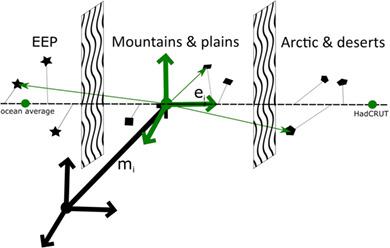当前位置:
X-MOL 学术
›
Int. J. Climatol.
›
论文详情
Our official English website, www.x-mol.net, welcomes your
feedback! (Note: you will need to create a separate account there.)
Classification of time series of temperature variations from climatically homogeneous regions based on long‐term persistence
International Journal of Climatology ( IF 3.5 ) Pub Date : 2020-12-24 , DOI: 10.1002/joc.6982 Darko Sarvan 1 , Milica Tošić 2 , Marko Borovinić 3 , Suzana Blesić 4, 5
International Journal of Climatology ( IF 3.5 ) Pub Date : 2020-12-24 , DOI: 10.1002/joc.6982 Darko Sarvan 1 , Milica Tošić 2 , Marko Borovinić 3 , Suzana Blesić 4, 5
Affiliation

|
We used detrended methods for scaling analysis (DFA2 and DMA) and wavelet transform spectral analysis (WTS) to characterize long‐term persistence (LTP) properties of temperature anomalies time series from observational stations from climatically and topologically homogeneous HadCRUT4 grid cells. We were interested to investigate the validity of the expectation that their LTP scaling properties remain preserved in the process of HadCRUT4 spatially interpolated and bias adjusted averaging, which was indeed the case in our selection. We additionally utilized the Hurst space analysis (HSA), a methodological solution that we recently developed, to classify climatic records from our dataset according to their LTP character and similarity of their WTS cyclical presentation. We were able to use HSA to observe four distinct patterns of climate dynamic behaviour according to the ‘preferred’ characteristic that those do not ‘belong to the ocean’. In this way, our results suggested that there probably exists a necessity to examine cycles in climate records as important elements of natural variability. To illustrate how the procedure developed in this article can be extended, we used HSA developed by the use of a dataset from climatically and topologically homogeneous regions to classified time series of teleconnection indices that may have influence on their regional climate. HSA can be further systematically utilized in this way, to link LTP properties of temperature anomalies with their possible spatially remote sources.
中文翻译:

基于长期持续性的气候均匀区域温度变化的时间序列分类
我们使用去趋势方法进行标度分析(DFA2和DMA)和小波变换频谱分析(WTS),以表征来自气候和拓扑均质的HadCRUT4网格单元的观测站温度异常时间序列的长期持续性(LTP)特性。我们有兴趣调查预期的有效性,即在HadCRUT4空间内插和偏差调整平均的过程中仍保留其LTP缩放属性,这在我们的选择中确实如此。我们还利用了我们最近开发的一种方法学解决方案Hurst空间分析(HSA),根据数据集的LTP特征和WTS循环表示的相似性,对数据集中的气候记录进行了分类。根据“不属于海洋”的“首选”特征,我们能够使用HSA观察四种不同的气候动态行为模式。这样,我们的结果表明,可能有必要检查气候记录中的循环,将其作为自然变异的重要因素。为了说明如何扩展本文中开发的过程,我们使用了HSA,该HSA是通过使用从气候和拓扑上均质的区域到可能影响其区域气候的远程连接指数的分类时间序列来开发的。HSA可以通过这种方式进一步系统地利用,以将温度异常的LTP属性与其可能的空间遥远源联系起来。这样,我们的结果表明,可能有必要检查气候记录中的循环,将其作为自然变异的重要因素。为了说明如何扩展本文中开发的过程,我们使用了HSA,该HSA是通过使用从气候和拓扑上均一的区域到可能影响其区域气候的远程连接指数的分类时间序列开发的数据集而开发的。HSA可以通过这种方式进一步系统地利用,以将温度异常的LTP属性与其可能的空间遥远源联系起来。这样,我们的结果表明,可能有必要检查气候记录中的循环,将其作为自然变异的重要因素。为了说明如何扩展本文中开发的过程,我们使用了HSA,该HSA是通过使用从气候和拓扑上均一的区域到可能影响其区域气候的远程连接指数的分类时间序列开发的数据集而开发的。HSA可以通过这种方式进一步系统地利用,以将温度异常的LTP属性与其可能的空间遥远源联系起来。我们使用通过从气候和拓扑上均一的区域的数据集开发的HSA,对可能影响其区域气候的远程连接指数的时间序列进行分类。HSA可以通过这种方式进一步系统地利用,以将温度异常的LTP属性与其可能的空间遥远源联系起来。我们使用通过从气候和拓扑上均一的区域的数据集开发的HSA,对可能影响其区域气候的远程连接指数的时间序列进行分类。HSA可以通过这种方式进一步系统地利用,以将温度异常的LTP属性与其可能的空间遥远源联系起来。
更新日期:2020-12-24
中文翻译:

基于长期持续性的气候均匀区域温度变化的时间序列分类
我们使用去趋势方法进行标度分析(DFA2和DMA)和小波变换频谱分析(WTS),以表征来自气候和拓扑均质的HadCRUT4网格单元的观测站温度异常时间序列的长期持续性(LTP)特性。我们有兴趣调查预期的有效性,即在HadCRUT4空间内插和偏差调整平均的过程中仍保留其LTP缩放属性,这在我们的选择中确实如此。我们还利用了我们最近开发的一种方法学解决方案Hurst空间分析(HSA),根据数据集的LTP特征和WTS循环表示的相似性,对数据集中的气候记录进行了分类。根据“不属于海洋”的“首选”特征,我们能够使用HSA观察四种不同的气候动态行为模式。这样,我们的结果表明,可能有必要检查气候记录中的循环,将其作为自然变异的重要因素。为了说明如何扩展本文中开发的过程,我们使用了HSA,该HSA是通过使用从气候和拓扑上均质的区域到可能影响其区域气候的远程连接指数的分类时间序列来开发的。HSA可以通过这种方式进一步系统地利用,以将温度异常的LTP属性与其可能的空间遥远源联系起来。这样,我们的结果表明,可能有必要检查气候记录中的循环,将其作为自然变异的重要因素。为了说明如何扩展本文中开发的过程,我们使用了HSA,该HSA是通过使用从气候和拓扑上均一的区域到可能影响其区域气候的远程连接指数的分类时间序列开发的数据集而开发的。HSA可以通过这种方式进一步系统地利用,以将温度异常的LTP属性与其可能的空间遥远源联系起来。这样,我们的结果表明,可能有必要检查气候记录中的循环,将其作为自然变异的重要因素。为了说明如何扩展本文中开发的过程,我们使用了HSA,该HSA是通过使用从气候和拓扑上均一的区域到可能影响其区域气候的远程连接指数的分类时间序列开发的数据集而开发的。HSA可以通过这种方式进一步系统地利用,以将温度异常的LTP属性与其可能的空间遥远源联系起来。我们使用通过从气候和拓扑上均一的区域的数据集开发的HSA,对可能影响其区域气候的远程连接指数的时间序列进行分类。HSA可以通过这种方式进一步系统地利用,以将温度异常的LTP属性与其可能的空间遥远源联系起来。我们使用通过从气候和拓扑上均一的区域的数据集开发的HSA,对可能影响其区域气候的远程连接指数的时间序列进行分类。HSA可以通过这种方式进一步系统地利用,以将温度异常的LTP属性与其可能的空间遥远源联系起来。











































 京公网安备 11010802027423号
京公网安备 11010802027423号